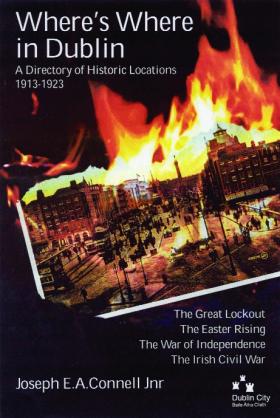Where’s where in Dublin: a directory of historic locations 1913–1923
Published in 20th-century / Contemporary History, Book Reviews, Issue 6 (Nov/Dec 2006), Reviews, Revolutionary Period 1912-23, Volume 14 Where’s where in Dublin: a directory of historic locations 1913–1923
Where’s where in Dublin: a directory of historic locations 1913–1923
Joseph Connell
(Four Courts Press, ?15pb, ?29.95hb)
ISBN 9780946841820This book has been in the making for more than ten years. A decade of research has culminated in an extremely useful compendium to the history of early twentieth-century Ireland. The author is a practising lawyer in Florida but clearly has an unrivalled capacity for detailed knowledge of his adopted city and the part that Dublin played in the struggle for independence. He has read and researched the subject-matter extensively and has meticulously included almost every address where relevant characters lived or where important incidents occurred.
Few would argue that an undertaking of this magnitude would have been better left to a committee of authors and researchers working together (and, perhaps better still, living in Dublin). Connell has proven that his solo approach, complemented by his regular research trips to Ireland and an obvious enthusiasm for his subject, has paid dividends. Where’s where will be used for some time to come as a reference book for Irish historians, students, teachers, guides, researchers or just about anyone with even a minor interest in this period. With such a vast number of addresses it would not be surprising to see many people buying this book as proof that their house played a small part in the fight for Irish freedom. A typical example of a few entries taken at random:
—5 Cabra Road: Michael Foley’s home, where Collins first met Ned Broy.
—14 Grafton Street: Trinity College Officer’s Training Corps Commemorative Fund: Secretary, Lewis Beatty.
—20 Fontenoy Street: Seán Heuston’s mother’s home; Seán lived here before the Rising.
Connell has included an appendix of addresses associated with Michael Collins. Many of these addresses will be familiar to Collins enthusiasts but additional gems of information are included. There is a very informative piece on Bloody Sunday. The proximity of the addresses where the British agents were lodging when they were executed is interesting: 92 Lower Baggot Street, 119 Lower Baggot Street, 22 Lower Mount Street, 38 Upper Mount Street—all within gunshot-hearing distance of each other.
Another valuable use for Connell’s book will be as a definitive guide to the places that require some form of commemorative plaque. The recent allegations that renumbering of Moore Street invalidated no. 16 as the final HQ of the GPO battalion during the dying hours of the Easter Rising are easily proven to be unfounded. It is the lesser-known buildings that are in danger of being unsympathetically redeveloped. In fact, a glance at an entry for 206 Pearse Street reveals it to have been the former HQ of the Irish Volunteers. This building is currently undergoing renovation, so now would be a good time to contact the developers in order that a plaque be put on the building for future generations, especially considering the renewed interest and enthusiasm shown during this year, the ninetieth anniversary of the Rising.
The third appendix in Where’s where contains a diverse range of statements and documents from 1913–23, including the manifesto of the Irish Volunteers, General Blackadder’s statement after Pearse’s court martial, Joseph Plunkett’s will, and George Bernard Shaw’s letter to Hannie Collins dated 23 August 1922. Although many of these statements are available in other books, owing to their diverse nature one would need access to a very extensive library to collate this information.
In Appendix 4, ‘Organisations and garrisons, songs, plays, uniforms, flags and emblems’, there is a motley but wonderful selection of anecdotes and information. One I found particularly interesting and informative reads:
‘The Irish National Guard: In 1911 Augustine (Gussy) Finlay, a member of Na Fianna Éireann, founded the Irish National Guard as a youth organisation for the sons and daughters of the working class. Later it became an adjunct of the Irish Citizen Army. Their motto was: “The Guard Dies but Never Surrenders”. In line with the equality views of the Citizen Army, there was a female section of the Guard. Most members had pistols or shotguns. The Guard did not fight as a unit in the Rising, but its members merged with various companies of the Citizen Army.’
Connell has made a heroic (and some would say brave) attempt to list the names of those who fought in the GPO in 1916. His list comes to a total of a little over 180. On the other hand, John O’Connor’s handy reference book The 1916 Proclamation (Anvil Books, 1986 and 1999) contains a thorough roll of honour for the GPO of over 410. The difference is that Connell gives a few lines of information beside each named individual, and also his list makes no claims to be the roll of honour. Both authors should be applauded and it should be mandatory that every public house in Dublin has a copy of each book to verify the inevitable ‘My granddad was in the GPO’ discussion.
Dublin City Council commissioned this book as part of their commemorative programme for the ninetieth anniversary of the Rising (and, it would appear, spared no expense in the printing). Finally, owing to its extensive nature, a mention should be made of the incredible bibliography, which stands alone as a reference guide.
Lorcan Collins is a founder of the 1916 Rebellion historical walking tour of Dublin.
















